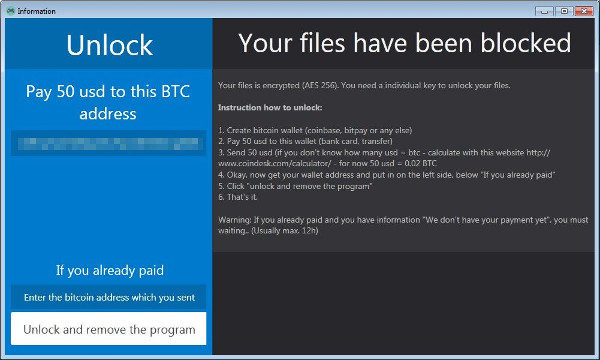RANSOM_BLOCKER.R00XC0OI517
Ransom-Nulltica!B553D120875E (McAfee); Trojan-Ransom.Win32.Blocker.kgwu (Kaspersky); Ransom.HiddenTear!g1 (Symantec)
Windows


Threat Type: Ransomware
Destructiveness: No
Encrypted: No
In the wild: Yes
OVERVIEW
This Ransomware arrives on a system as a file dropped by other malware or as a file downloaded unknowingly by users when visiting malicious sites.
It encrypts files found in specific folders.
TECHNICAL DETAILS
2,926,080 bytes
EXE
Yes
03 Sep 2017
Arrival Details
This Ransomware arrives on a system as a file dropped by other malware or as a file downloaded unknowingly by users when visiting malicious sites.
Installation
This Ransomware drops the following copies of itself into the affected system and executes them:
- %Application Data%\{malware name}
(Note: %Application Data% is the Application Data folder, where it usually is C:\Documents and Settings\{user name}\Application Data on Windows 2000, Windows Server 2003, and Windows XP (32- and 64-bit); C:\Users\{user name}\AppData\Roaming on Windows Vista (32- and 64-bit), Windows 7 (32- and 64-bit), Windows 8 (32- and 64-bit), Windows 8.1 (32- and 64-bit), Windows Server 2008, and Windows Server 2012.)
It drops the following files:
- %Application Data%\log.txt -> key for the encrypted files
(Note: %Application Data% is the Application Data folder, where it usually is C:\Documents and Settings\{user name}\Application Data on Windows 2000, Windows Server 2003, and Windows XP (32- and 64-bit); C:\Users\{user name}\AppData\Roaming on Windows Vista (32- and 64-bit), Windows 7 (32- and 64-bit), Windows 8 (32- and 64-bit), Windows 8.1 (32- and 64-bit), Windows Server 2008, and Windows Server 2012.)
It adds the following mutexes to ensure that only one of its copies runs at any one time:
- Global\ControlPanel
Autostart Technique
This Ransomware adds the following registry entries to enable its automatic execution at every system startup:
HKEY_CURRENT_USER\SOFTWARE\Microsoft\
Windows\CurrentVersion\Run
Window = "%Application Data%\{malware name}"
Process Termination
This Ransomware terminates processes or services that contain any of the following strings if found running in the affected system's memory:
- iexplore
- iexplorer
- chrome
- firefox
- MicrosoftEdge
Other Details
This Ransomware connects to the following URL(s) to check for an Internet connection:
- google.pl
It does the following:
- It connects to the URL "http://bit.ly/2razNDz" which will then be redirected to "http://www.wikihow.com/Send-Bitcoins"
- It tries to steal saved login credentials from the following browsers:
- Chrome
- Firefox
- IE10
- It opens the following URL then attempts to login the stolen credentials:
- http://facebook.com/login.php
- It lists all friends of the current account on Facebook and sends each one of them a message containing the malware and the following text:
- To jest wiadomosc wyslana w calosci przez mojego bota
- It adds the extension ".lock" to encrypted files then renames it back to the original file name during encryption.
- It adds the extension ".unlock" to encrypted files then renames it back to the original file name during decryption.
- It opens a GUI that serves as a ransom note:

- It has the capability to decrypt the encrypted files once the ransom is paid.
- It adds the following registry entry to disable the CTRL key:
- HKEY_LOCAL_MACHINE\SYSTEM\CurrentControlSet\Control\Keyboard Layout
- Scancode Map = "0,0,0,0,0,0,0,0,3,0,0,0,0,0,29,0,0,0,29,224,0,0,0,0"
- Scancode Map = "0,0,0,0,0,0,0,0,3,0,0,0,0,0,29,0,0,0,29,224,0,0,0,0"
- HKEY_LOCAL_MACHINE\SYSTEM\CurrentControlSet\Control\Keyboard Layout
Ransomware Routine
This Ransomware encrypts files found in the following folders:
- C:\Program Files (x86)
- %Program Files%
- %Application Data%
- %Desktop%
- {Removable Drives}
(Note: %Program Files% is the Program Files folder, where it usually is C:\Program Files on all Windows operating system versions; C:\Program Files (x86) for 32-bit applications running on Windows 64-bit operating systems.. %Application Data% is the Application Data folder, where it usually is C:\Documents and Settings\{user name}\Application Data on Windows 2000, Windows Server 2003, and Windows XP (32- and 64-bit); C:\Users\{user name}\AppData\Roaming on Windows Vista (32- and 64-bit), Windows 7 (32- and 64-bit), Windows 8 (32- and 64-bit), Windows 8.1 (32- and 64-bit), Windows Server 2008, and Windows Server 2012.. %Desktop% is the desktop folder, where it usually is C:\Documents and Settings\{user name}\Desktop in Windows 2000, Windows Server 2003, and Windows XP (32- and 64-bit); C:\Users\{user name}\Desktop in Windows Vista (32- and 64-bit), Windows 7 (32- and 64-bit), Windows 8 (32- and 64-bit), Windows 8.1 (32- and 64-bit), Windows Server 2008, and Windows Server 2012.)
It avoids encrypting files with the following strings in their file name:
- *.exe
- *.lnk
- Microsoft
It avoids encrypting files with the following strings in their file path:
- Microsoft
SOLUTION
9.850
13.641.06
03 Sep 2017
13.642.00
04 Sep 2017
Step 1
Before doing any scans, Windows XP, Windows Vista, and Windows 7 users must disable System Restore to allow full scanning of their computers.
Step 2
Note that not all files, folders, and registry keys and entries are installed on your computer during this malware's/spyware's/grayware's execution. This may be due to incomplete installation or other operating system conditions. If you do not find the same files/folders/registry information, please proceed to the next step.
Step 3
Restart in Safe Mode
Step 4
Delete this registry value
Important: Editing the Windows Registry incorrectly can lead to irreversible system malfunction. Please do this step only if you know how or you can ask assistance from your system administrator. Else, check this Microsoft article first before modifying your computer's registry.
- In HKEY_CURRENT_USER\SOFTWARE\Microsoft\Windows\CurrentVersion\Run
- Window = "%Application Data%\{malware name}"
- Window = "%Application Data%\{malware name}"
- In HKEY_LOCAL_MACHINE\SYSTEM\CurrentControlSet\Control\Keyboard Layout
- Scancode Map = "0,0,0,0,0,0,0,0,3,0,0,0,0,0,29,0,0,0,29,224,0,0,0,0"
- Scancode Map = "0,0,0,0,0,0,0,0,3,0,0,0,0,0,29,0,0,0,29,224,0,0,0,0"
Step 5
Search and delete this file
- %Application Data%\log.txt
Step 6
Restart in normal mode and scan your computer with your Trend Micro product for files detected as RANSOM_BLOCKER.R00XC0OI517. If the detected files have already been cleaned, deleted, or quarantined by your Trend Micro product, no further step is required. You may opt to simply delete the quarantined files. Please check this Knowledge Base page for more information.
Step 7
Restore encrypted files from backup.
Did this description help? Tell us how we did.


